$5 Off First Order + 5% Off After
Become a free registered member and get access to exclusive discounts, resources, and a community of like-minded educators.
Not sure yet? See what you’ll get: Member benefits
AC9HPFP01
》Health and Physical Education – Foundation
Investigate who they are and the people in their world
Elaborations
• making personal connections with stories that explore identity and belonging; discussing who they are, where they come from and people in their lives
• exploring similarities and differences in family structures in First Nations Australian communities and other cultures
• exploring cultural practices from different cultures, including the cultures of Asia, that are important to individuals, families and communities
• identifying different families in their communities; for example, 2-parent, single-parent, extended and non-traditional families
• identifying ways they use their strengths in physical activities to help themselves and others to be successful
• recognising that they have a right to belong and contribute to a variety of groups
-
[T4R] A Family is a Family is a Family: L2 Making Predictions
📔 A Family Is a Family Is a Family by Sara O’Leary• We are learning to make predictions about the text.



![[T4R] A Family is a Family is a Family Reading Unit for Foundation Year](https://stevendegc.com.au/wp-content/uploads/2025/03/T4R-A-Family-is-a-Family-UnitOverview.jpg)
![[T4R] A Family is a Family is a Family: L2 Making Predictions](https://stevendegc.com.au/wp-content/uploads/2025/03/T4R-A-Family-is-a-Family-L2-Cover.jpg)
